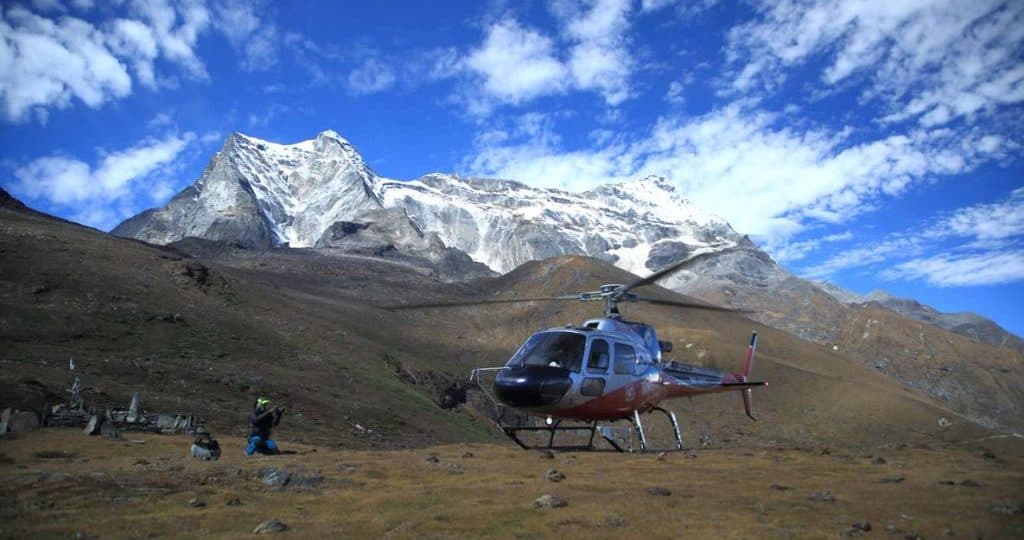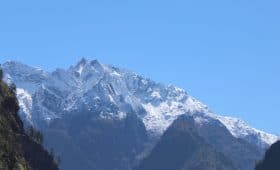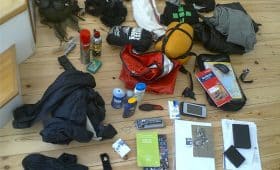Everest Base Camp Trek offers an exciting adventure, showcasing the best of mountain climbing, extreme sports and exploration. It takes you through stunning landscapes and lets you experience different cultures.
This short Everest Base Camp trek journey lasts for 9 days and gives you a taste of what the Everest region is all about. It’s designed carefully to keep you safe, help you adjust to the altitude and make sure you have a great time.
During the shortest yet safest EBC trek, you’ll walk along beautiful trails, learn about local customs and see breathtaking views that you’ll remember forever.
Along the way, you’ll face various challenges, but you’ll also feel a great sense of accomplishment as you overcome them. Everest Base Camp Trek is a testament to how determined and resilient people can be when they pursue adventure.
In short, this short Everest Base Camp trek combines natural beauty, cultural experiences and personal satisfaction, making it a must-do for anyone looking for the ultimate adventure.
Table of Contents
- Why is this trek shorter than others to Everest Base Camp?
- Short Everest Base Camp Trek Itinerary
- Day 1: Lukla to Phakding
- Day 2: Phakding to Namche Bazaar
- Day 3: Acclimatization Day in Namche Bazaar
- Day 4: Namche Bazaar to Tengboche
- Day 5: Tengboche to Dingboche
- Day 6: Acclimatization Day in Dingboche
- Day 7: Dingboche to Lobuche
- Day 8: Lobuche to Everest Base Camp to Gorak Shep
- Day 9: Gorak Shep to Kathmandu via Helicopter
- Cultural Immersion
- Is this short Everest Base Camp trek itinerary suitable for me?
- Safety Measures
- Fitness Requirements for Short Everest Base Camp Trek
- Weather and Temperature
- Best Season
- What to Pack
- Availability of Short Everest Base Camp Trek in 2024
- Testimonials of Our Previous Customers
- Practical Tips
- Frequently Asked Questions (FAQs)
- What is the altitude of Everest Base Camp?
- Do I need prior trekking experience?
- How do I prevent altitude sickness?
- Are there ATM facilities along the trekking route?
- What kind of accommodation can I expect in 2024 around the EBC trail?
- Is bottled water available along the trail?
- What permits do I need for the trek?
- Are there medical facilities available during the trek?
- Is Wi-Fi available on the trekking route?
- How physically demanding is the trek?
- Are there restroom facilities along the trail?
- Can I charge my electronic devices during the trek?
- What is the food like during the trek?
- Are there any cultural customs I should be aware of?
- Is travel insurance necessary?
- What is the terrain like along the trekking route?
- Are there any age restrictions for the trek?
- Can I trek during the off-season?
- What happens in case of emergencies?
- Is it possible to extend the trek?
- Environmental Sustainability
- Alternative Routes
- Summary
Why is this trek shorter than others to Everest Base Camp?
Everest Base Camp Trek with a helicopter return trip is remarkable and shorter in duration. It’s designed to ensure our safe arrival at EBC while allowing for proper acclimatization, thus reducing the overall number of days by eliminating the return walk.
This particular itinerary stands out as the only one that enables you to experience the EBC trail fully without compromising safety. We’ve incorporated two acclimatization days along the route to guarantee a safe and enjoyable journey.
Short Everest Base Camp Trek Itinerary
Day 1: Lukla to Phakding
Our journey begins with a short flight to Lukla, where we commence our trek to Phakding. During peak seasons like spring (March to May) and autumn (late September to early December), Lukla flights often depart from Ramechap. Therefore, if you are trekking during peak season, we will have a 4-hour drive to Ramechap early in the morning to catch the flight to Lukla. Phakding, nestled amidst beautiful landscapes, welcomes us after approximately 3.5 hours of trekking.
Day 2: Phakding to Namche Bazaar
We follow winding trails leading us to Namche Bazaar, the vibrant heart of the Khumbu region. The journey takes about 7 hours, providing us with glimpses of the majestic Himalayan surroundings.
Day 3: Acclimatization Day in Namche Bazaar
Today is dedicated to leisurely exploration and acclimatization in Namche Bazaar. To help our bodies adjust to the higher altitude, we hike to higher altitude areas like Syangboche and return to Namche for overnight stay. As we acclimatize, we immerse ourselves in the rich Sherpa culture that pervades the bustling streets of this popular town, known as the gateway to Everest.
Day 4: Namche Bazaar to Tengboche
Our trek continues, guiding us to Tengboche, renowned for its ancient Tengboche monastery and breathtaking mountain panoramas. Today’s trek is approximately 5 hours, offering a memorable and beautiful trail.
Day 5: Tengboche to Dingboche
We ascend further to Dingboche, a picturesque village within high Himalayan peaks and pristine landscapes. Today’s walk from Tengboche to Dingboche, lasting around 5 hours, presents us with amazing views that capture the essence of the Himalayas.
Day 6: Acclimatization Day in Dingboche
Today, we explore the tranquility of Dingboche, allowing ourselves time to acclimatize to the higher altitude. Our acclimatization hike will take us to Nagartsang peak, where we can explore the scenic surroundings, absorbing the serenity that envelops us.
Day 7: Dingboche to Lobuche
Our trekking trail unfolds further as we make our way to Lobuche, tracing the steps of legendary mountaineers amidst the dramatic Himalayan landscapes. Today’s walk takes approximately 5 hours, offering moments of reflection and admiration.
Day 8: Lobuche to Everest Base Camp to Gorak Shep
Today marks the main day of our adventure as we trek to Everest Base Camp, standing in the shadow of the world’s highest snow covered mountain. After experiencing the magnificence of Everest Base Camp, we descend to Gorak Shep, preparing for an unforgettable sunrise tour to Kalapatthar. The trek time varies, ensuring we soak in every moment of this extraordinary walk.
Day 9: Gorak Shep to Kathmandu via Helicopter
Early in the morning, we visit Kalapatthar to witness the sunrise rays over the Himalayas, making it one of the best viewpoints of this trek. We return to Gorakshep and our epic adventure concludes with a scenic helicopter ride back to Kathmandu, where we cherish the memories of our Everest Base Camp odyssey, forever imprinted in our hearts.
Want more information? Send us your query, and our experts will get back to you within 24 hrs.
Cultural Immersion
Beyond the physical challenges and natural beauty, this short Everest Base Camp trek offers a profound opportunity for cultural immersion. Trekking through the most popular Khumbu region, trekkers have the chance to interact with Sherpa communities, whose rich culture and traditions are deeply intertwined with the Himalayan landscape.
Visits to monasteries along the trek route offer glimpses into centuries-old Buddhist practices and beliefs. Trekkers can witness prayer ceremonies at Tengboche monastery, explore ancient artifacts and engage in meaningful conversations with resident monks, gaining insights into a way of life shaped by spirituality and resilience.
Throughout the journey, encounters with local villagers provide opportunities to learn about traditional customs and rituals. From sharing meals with Sherpa families to participating in cultural festivities, trekkers make connections that go beyond language barriers, fostering a deeper appreciation for the cultural variations of the Himalayas.
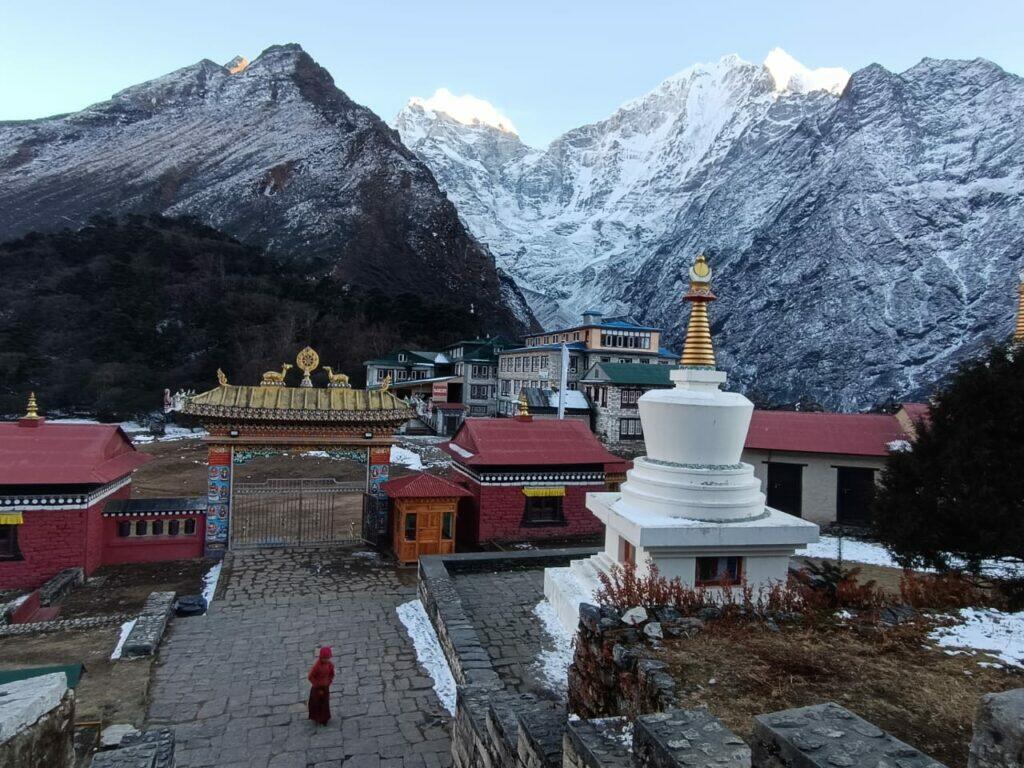
Is this short Everest Base Camp trek itinerary suitable for me?
Well, this itinerary is for everyone who is looking to experience this extraordinary journey reaching the base of the world’s highest mountain. Whether you are a reasonably fit person, a marathon runner or someone with experience in high-altitude trekking above 5000 meters, this trek is for you.
Mosaic Adventure has carefully planned this itinerary to ensure it fits everyone, no matter their fitness level, altitude of origin, age group or any other differences from one human to another; naturally, we are all the same and altitude will treat you similarly.
Safety Measures
Safety plays most important role when hiking the trail to reach the Everest Base Camp. While the journey promises awe-inspiring landscapes and unforgettable experiences, it also presents certain risks, particularly related to altitude sickness. Altitude sickness, if not properly managed, can pose serious health threats to trekkers.
To mitigate these risks, proper acclimatization is essential. Acclimatization days are strategically built into this short itinerary to allow trekkers’ bodies to adjust gradually to the increasing altitude. These rest days not only reduce the likelihood of altitude sickness but also enhance the overall trekking experience by ensuring trekkers feel their best throughout the journey.
Moreover, guidance from experienced professionals is invaluable. Mosaic Adventure’s team of guides is well-versed in the challenges of high-altitude trekking and equipped to provide assistance and support every step of the way.
They are trained to recognize the early signs of altitude sickness and take necessary precautions to ensure the safety and well-being of trekkers.
Fitness Requirements for Short Everest Base Camp Trek
So, have you made up your mind and want to take on the challenge of reaching Everest Base Camp? It’s a thrilling adventure set amidst the Himalayas. But before you lace up your boots, it is important to make sure you are ready, both physically and mentally, for the challenge ahead. Here is what you need to know about the fitness requirements:
Stay Fit
You’ll need decent cardio fitness and stamina to handle the tough terrain and high altitudes. EBC trek involves hours of walking every day, often on rough and steep paths. So, get into a routine of regular aerobic exercises like walking, jogging, cycling or swimming to build up your endurance. You can start practicing long walks with a backpack; it really helps among others.
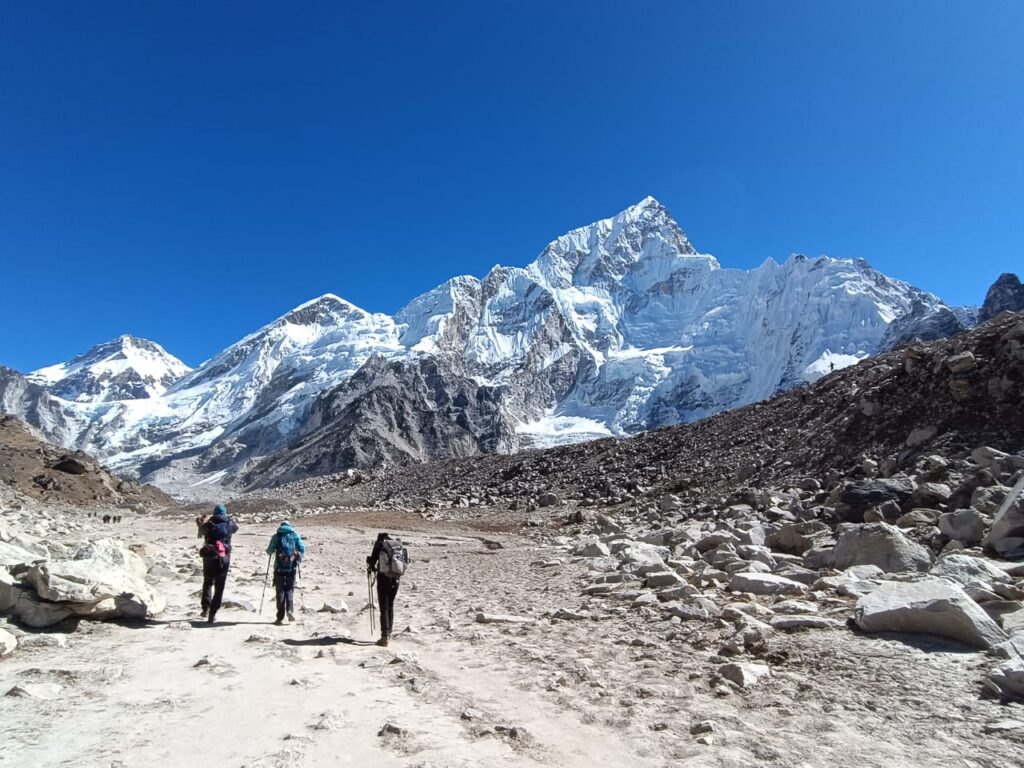
Build Strength
Trekking in the Everest region demands strength, especially in your legs, core and upper body. Add strength training exercises to your workout routine like squats, lunges, calf raises and core workouts to strengthen your muscles and improve stability.
No Previous Experience Required
You don’t need prior trekking experience to tackle Everest Base Camp, but it can be helpful to have some familiarity with multi-day hikes and different types of terrain. However, with determination, a positive mindset and guidance from experienced guides, anyone can complete the trek successfully.
Stay Mentally Strong
Trekking to Everest Base Camp isn’t just physically demanding; it’s mentally challenging too. Be prepared for long days of walking, unpredictable weather and basic accommodations along the trail. Keeping a positive attitude, staying motivated and embracing the adventure will make your journey more fulfilling. Expect low amenities and high Himalayan views and cultural immersion.
Understand How Altitude Works
Going to higher altitudes is a real concern when trekking to Everest Base Camp, where you’ll be climbing to heights over 5,000 meters (16,404 feet). Proper acclimatization is key to avoiding altitude-related issues like acute mountain sickness (AMS) or pulmonary and cerebral edema.
Choosing a Mosaic Adventure planned itinerary is a good way for you to safely reach the destination; our itinerary includes gradual altitude gains and acclimatization days to help your body adjust to the thin air and lower oxygen levels. Take one step at a time and do not push yourself.
In a nutshell, if you’re considering the Everest Base Camp Trek, assess your fitness level, train for cardio and strength, get used to the altitude and mentally prepare yourself for EBC journey.
With the right preparation, determination, respect for the environment and trekking with a reputable local agency, you’ll have an unforgettable adventure to one of the world’s most popular destinations: Everest Base Camp.
Weather and Temperature
In Nepal, there are basically four seasons, each with its distinctive characteristics, further explained below.
Spring
From March to May, spring brings mild temperatures to the Everest Base Camp region, typically ranging from 10°C to 15°C (50°F to 59°F) at altitudes below 3000 meters. As you ascend above 3000 meters to 5500 meters, temperatures become quite cold.
Daytime temperatures can be slightly above freezing, but nighttime temperatures can drop to around minus 2/3 to minus 10/12 degrees Celsius.
Days are generally pleasant, with occasional rain showers adding to the lush greenery of the landscape.
Spring is considered one of the best times for trekking to EBC due to the clear skies and blooming rhododendrons along the trail.
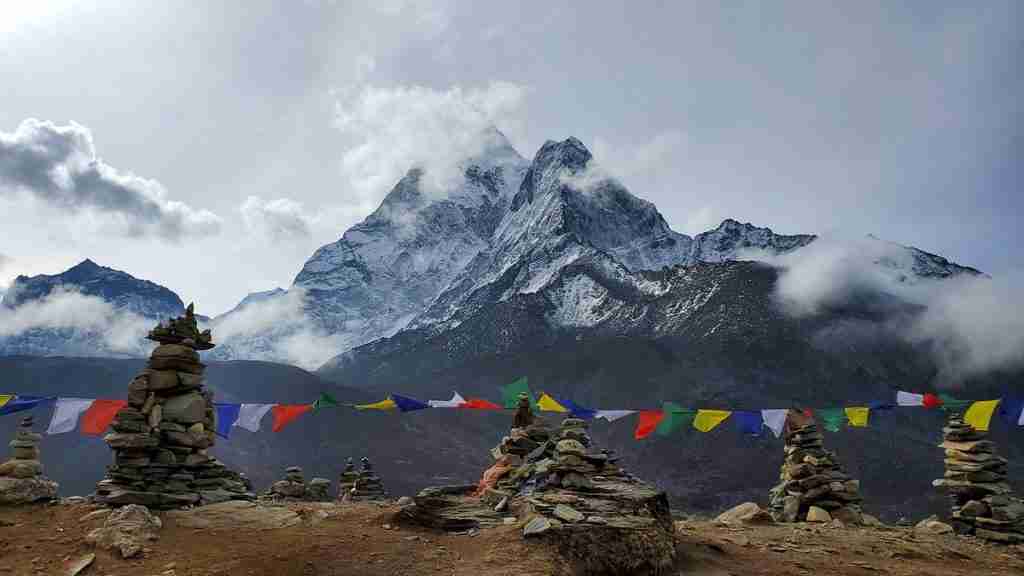
Autumn
September to November marks autumn in the Everest region, characterized by crisp and clear days with temperatures ranging from 10°C to 20°C (50°F to 68°F) at altitudes below 3000 meters. As you ascend above 3000 meters to 5500 meters, temperatures remain cold.
Daytime temperatures can hover around minus 3 to minus 5 degrees Celsius, while nighttime temperatures can drop to around minus 2/3 to minus 15/17 degrees Celsius.
The weather is stable, offering excellent visibility of the surrounding peaks, including Mount Everest.
Autumn is the peak trekking season for EBC due to the favorable weather conditions and breathtaking views.
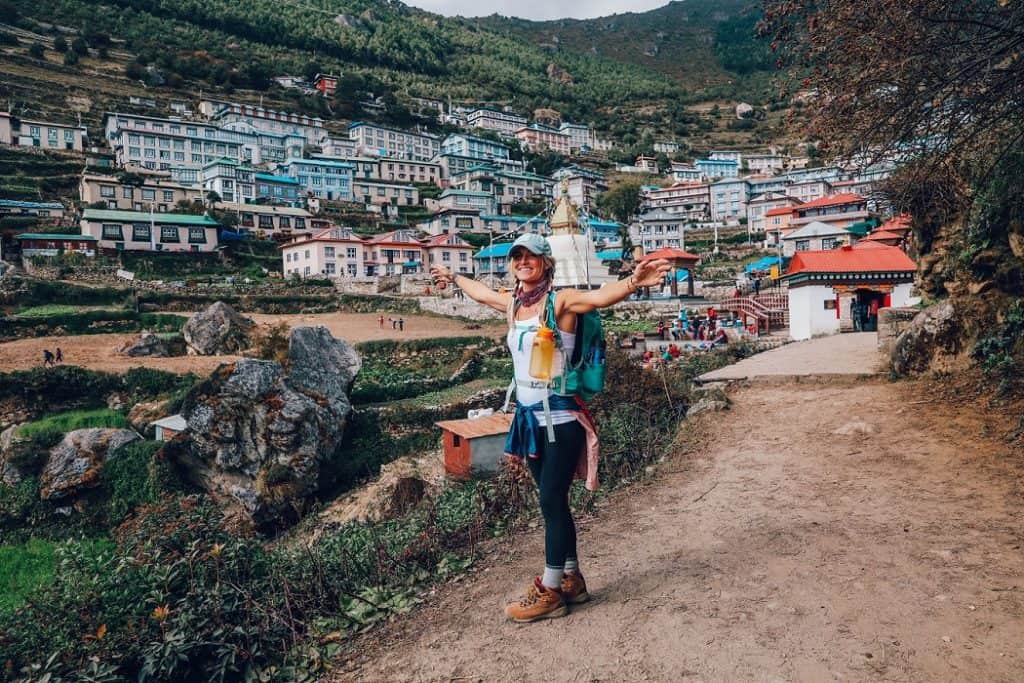
Winter
From December to February, winter sets in, bringing harsh cold and freezing temperatures to Everest Base Camp. Temperatures are mostly below freezing regardless of altitude.
Temperatures at the highest altitudes like EBC can drop as low as minus 25 degrees Celsius or even lower.
Snowfall is common, and the trails may be icy and challenging to navigate.
Winter trekking to EBC requires proper cold-weather gear and preparation for the extreme conditions.
Summer (or monsoon)
June to August brings the monsoon season to the Everest region, characterized by heavy rainfall, cloudy skies, and high humidity. Temperatures during summer months typically range from 10°C to 15°C (50°F to 59°F) at altitudes below 3000 meters.
As you ascend above 3000 meters to 5500 meters, temperatures become slightly colder again. Daytime temperatures can be around 3 to minus 2 degrees Celsius, while nighttime temperatures can drop to around minus 1/2 to minus 4/5 degrees Celsius.
Humidity levels can make it feel warmer. The trails become muddy and slippery, making trekking difficult and hazardous.
Summer is considered the least favorable time for trekking to EBC due to the unpredictable weather and limited visibility of the mountain peaks.
Understanding the seasonal variations in weather and temperature is crucial for planning a successful trek to Everest Base Camp. Depending on personal preferences and tolerance for different weather conditions, trekkers can choose the best time to embark on this iconic journey amidst the awe-inspiring landscapes of the Himalayas.
Best Season
You have just read about the four major seasons in Nepal and the temperature range of the Everest region along with general weather conditions. To avoid the monsoon and harsh winter months, trekkers choose spring and autumn for trekking to EBC.
Therefore, the best trekking seasons for the Everest Base Camp Trek are spring (March to May) and autumn (September to November), offering clear skies, moderate temperatures and stunning views.
Although this trip is available throughout the year, Mosaic Adventure suggests that you choose spring and autumn to enjoy it at its best.
What to Pack
Your ultimate packing list for the EBC Trek should consist of various clothes and gear, including sturdy trekking boots, warm clothing layers, a durable backpack, trekking poles, water purification tablets, high SPF sunscreen, a first aid kit and a camera to capture the mesmerizing landscapes.
Do your research and make sure you pack according to the season you are going so that you are ready for the weather conditions and temperatures that you are experiencing on this legendary adventure.

Availability of Short Everest Base Camp Trek in 2024
Our Everest Base Camp Trek is available throughout 2024. Choose any date that works for you.
If this shorter itinerary is not suitable for you, then you can also opt for our standard Everest Base Camp trek, which lasts 14 days. This all-inclusive tour costs just USD 1445 per person.
Testimonials of Our Previous Customers
We have helped thousands of adventure lovers reach Everest Base Camp, either through its standard EBC trek or the shortest Everest Base Camp trek.
We have requested them to share their firsthand experiences through TripAdvisor, the largest travel review portal. You can read about our customers’ reviews/testimonials by following this link.
Practical Tips
Preparation is key to a successful Everest Base Camp Trek. In addition to packing essentials, trekkers should focus on physical conditioning exercises to build endurance and strength for the challenging terrain. Footwear selection is crucial, with sturdy trekking boots recommended to provide stability and support on uneven trails.
Trekkers should also consider investing in trekking poles to alleviate strain on joints and muscles during steep ascents and descents. Managing trekking gear effectively is essential for staying organized and comfortable throughout the journey.
Packing light and prioritizing essential items can help streamline the trekking experience, allowing trekkers to focus on enjoying the breathtaking landscapes and cultural immersion opportunities that await them.
Moreover, when choosing the best company for the EBC trek, don’t just compare prices. Make sure you are signing up for a safe itinerary, your guides/porters are well-treated and paid, and your money is well-used by the company you are choosing.
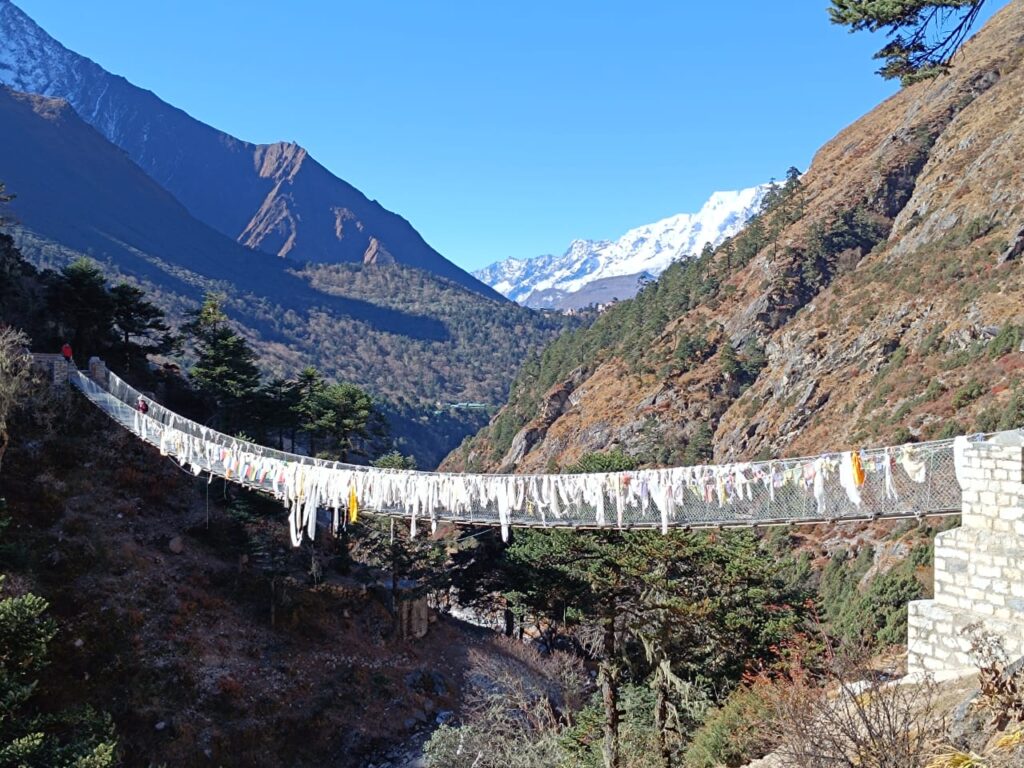
Frequently Asked Questions (FAQs)
What is the altitude of Everest Base Camp?
Everest Base Camp is located at a height of 5,364 meters (17,598 feet) above sea level.
Do I need prior trekking experience?
While prior trekking experience is helpful, it’s not required. However, being in good physical shape is important.
How do I prevent altitude sickness?
To avoid altitude sickness, walk slowly while ascending, drink plenty of water, and listen to your body. Consider taking medication like Diamox if advised by a doctor.
Always listen to your guide as they can provide you with the right information tailored to your personal needs.
Are there ATM facilities along the trekking route?
ATM facilities are not usually available along the trekking route, so bring enough cash (Nepalese Rupees) with you. As of early 2024, there are only ATM machines in Lukla and Namche, and they aren’t always reliable.
Cash is essential to avoid running out of money while on such a rural trail. During the trek, you can exchange globally accepted currencies like USD/EUROS/GBP to NPR, but the exchange rates are a bit low.
What kind of accommodation can I expect in 2024 around the EBC trail?
Accommodations along the trek vary from basic teahouses to slightly more comfortable lodges with shared facilities. The teahouse facilities have been developing every year leading up to 2024, but they are still mountain/rural lodges, so don’t expect too much.
Is bottled water available along the trail?
Yes, bottled water is available at teahouses, but it’s advisable to bring water purification tablets or a filtering system to minimize plastic waste.
What permits do I need for the trek?
You’ll need two permits: the Sagarmatha National Park Entry Permit and the Khumbu Pasang Lhamu Rural Municipality Entry Permit.
When booking a tour with agencies like Mosaic Adventure, these permits are included in your tour package.
Are there medical facilities available during the trek?
Basic medical facilities are available at some points along the trek, such as Lukla and Namche, but it’s best to bring your own medical kit. Make sure to consult your guide before taking any medicines along the trail.
Is Wi-Fi available on the trekking route?
Some teahouses offer Wi-Fi for a fee, but it’s not always reliable due to the remote location. Do not rely on this remote area Wi-Fi for any online work or video meetings.
How physically demanding is the trek?
The trek is challenging but manageable for those in good physical condition. It involves walking long distances and ascending steep terrain.
Are there restroom facilities along the trail?
Yes, there are restroom facilities along the trail, usually in the form of basic squat and Western toilets. However, during the day while on the trail, it can be difficult to find a toilet.
Can I charge my electronic devices during the trek?
Some teahouses offer charging facilities for electronic devices, but it’s wise to bring a portable charger as a backup. Solar-powered charging facilities are not 100% reliable.
What is the food like during the trek?
Food mainly consists of Nepali and Tibetan dishes like dal bhat (rice and lentils) and momos (dumplings), along with some Western and Chinese options.
Are there any cultural customs I should be aware of?
Respect local customs by removing shoes before entering homes or temples, asking permission before taking photos, and avoiding pointing with your finger. Read the do’s and don’ts in Nepal while planning your adventure.
Is travel insurance necessary?
Yes, travel insurance covering medical emergencies, evacuation and trip cancellation is highly recommended.
What is the terrain like along the trekking route?
The terrain varies from lush forests and suspension bridges to rocky paths and high-altitude moraines.
Are there any age restrictions for the trek?
There are no official age restrictions, but participants should be in good health and physical condition.
If your children can express their discomfort in such high-altitude areas, they are the right age group.
We don’t recommend bringing kids on this adventure if they are unable to communicate their discomfort.
Can I trek during the off-season?
Trekking during the off-season is possible but comes with additional challenges like extreme cold or heavy rainfall.
What happens in case of emergencies?
In emergencies, there are helicopter evacuation services available and our guide can assist in arranging help by contacting the main office in Kathmandu.
Is it possible to extend the trek?
Yes, you can extend the trek by exploring nearby areas like Gokyo Lakes or crossing over to the Khumbu Valley.
Environmental Sustainability
As responsible members of society and stewards of the environment, it is imperative that we prioritize responsible trekking practices. The fragile ecosystems of the Himalayas face increasing pressure from human activity, making sustainable trekking habits more crucial than ever before.
Trekkers can play a pivotal role in preserving the pristine beauty of the region by minimizing their environmental impact. This entails avoiding single-use plastics, adhering to waste disposal guidelines, refraining from playing loud music on the trail, respecting local culture and ways of living, choosing companies that treat their guides/porters with fair wages, refraining from damaging natural resources like rivers and waterfalls and respecting the natural surroundings by staying on designated trails.
By embracing sustainable practices, trekkers not only contribute to the preservation of the Himalayan environment but also ensure that future generations can continue to enjoy its wonders for years to come.
Alternative Routes
While Everest Base Camp Trek is undeniably a bucket-list adventure, there are alternative routes and extensions that cater to different preferences and fitness levels. For those seeking a more off-the-beaten-path experience, the Three Passes Trek offers unparalleled opportunities for exploration and adventure.
Alternatively, the Gokyo Lakes Trek boasts breathtaking views of turquoise lakes nestled amidst snow-capped peaks, making it a photographer’s paradise.
These alternative routes provide trekkers with diverse landscapes and cultural encounters, enhancing the overall trekking experience.
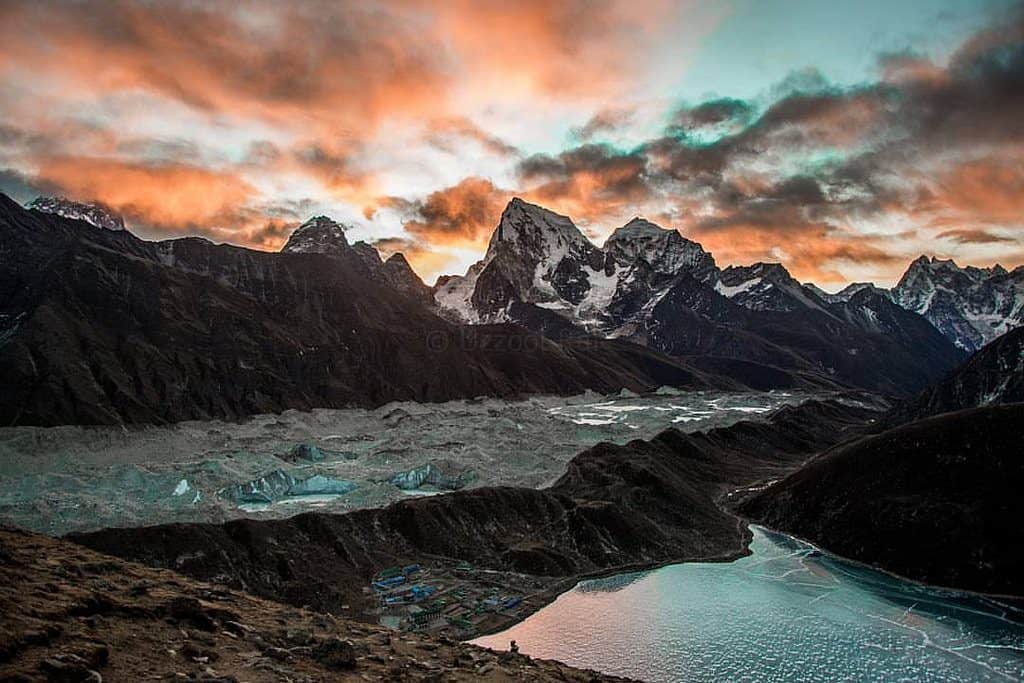
Summary
Short Everest Base Camp (EBC) trek offers a thrilling adventure condensed into 9 days, blending mountain climbing, cultural immersion and breathtaking scenery.
Designed for safety and acclimatization, the journey begins with a flight to Lukla and traverses through Phakding, Namche Bazaar, Tengboche, Dingboche and Lobuche before reaching Everest Base Camp and Gorak Shep. The trek culminates with a scenic helicopter ride back to Kathmandu.
This itinerary is suitable for trekkers of various fitness levels, emphasizing physical conditioning, mental preparedness and altitude acclimatization. Safety measures, including rest days and experienced guides, mitigate risks like altitude sickness. Spring and autumn are recommended seasons due to favorable weather conditions.
Cultural immersion enriches the experience, with opportunities to interact with Sherpa communities, visit monasteries and embrace local customs. Environmental sustainability is emphasized, urging responsible trekking practices to preserve the fragile Himalayan ecosystem.
Alternative routes like the Three Passes Trek and Gokyo Lakes Trek cater to diverse preferences, offering unique landscapes and cultural encounters. FAQs address common concerns regarding altitude sickness, weather, accommodations and permits.
Overall, the short EBC trek promises unforgettable memories and personal satisfaction, making it a must-do adventure for those seeking the ultimate Himalayan experience.
Want more information? Send us your query, and our experts will get back to you within 24 hrs.
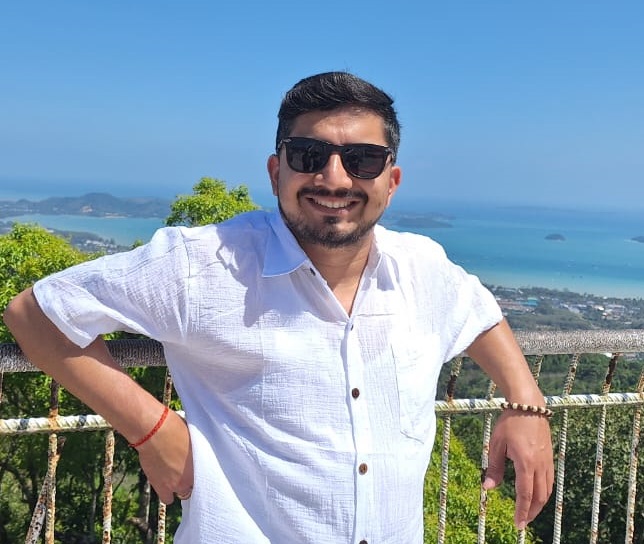
Madhav started working as a porter in 2001 and then moved on to work as a trekking guide. After working in the trekking and tourism industry for eight years, he co-founded Mosaic Adventure in 2009.
Madhav has trekked to most of the trekking destinations in Nepal, including Everest Base Camp Trek, Annapurna Base Camp, Annapurna Circuit Trek, Poon Hill Trek, Jomsom Muktinath Trek, Indigenous Peoples Trek, Langtang Valley Trek, Mardi Himal Trek, and all of the day hikes around Kathmandu.
He has also extensively traveled to other countries such as Australia, the USA, the UK, France, Hong Kong, Japan, China, the Philippines, the UAE, Saudi Arabia, Bahrain, Thailand, Turkey, and India. Madhav is the one who answers most of your questions about trekking and tours and helps to plan your trip by giving a personal touch.

